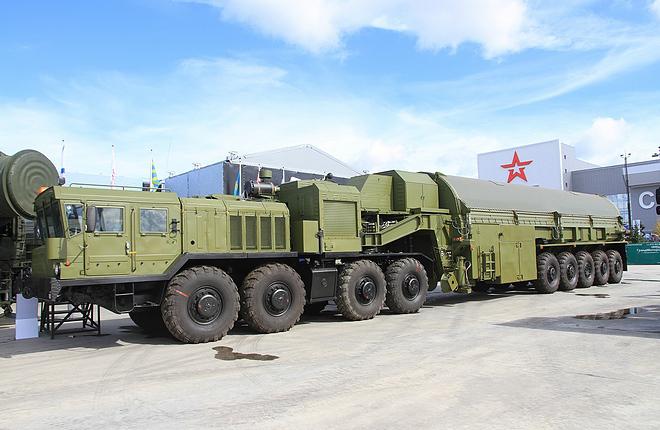Strategic missile transport/loader

The Russian Strategic Missile Forces (SMF) are showcasing the 3F30-9 transport/loader at Army 2016. The vehicle has never been shown to the general public before. A part of the ground infrastructure serving the Bulava submarine-launched ballistic missile system, it is designed to quickly transport the missiles along roads of any quality from storage facilities to piers for subsequent crane-assisted loading onto submarines or military transport. Each Bulava missile in its launch container measures 12.1 m in length and weighs over 36 t. The transport/loader is fitted with a sliding roof for ease of loading and unloading.
The ten-wheel, all-wheel-drive semi-articulated vehicle is towed by a KZKT-7428 truck tractor. The tractor is equipped with an auxiliary 246 kW diesel generator, which powers the launcher/transporter's hydraulic system and the electric motors on eight out of its 10 wheels. The 3F30-9 is fairly maneuverable: its turn radius is 25 m, which is comparable to the vehicle's overall length.
The 3F30-9 was developed by Motor Design Bureau, a subsidiary of the TsENKI ground infrastructure operator subordinate to the Russian Space Agency, which historically develops lifting and transportation equipment for the SMF. The new vehicle incorporates technical solutions previously used in 15T145M transport/loaders for other SMF missile types.
Ссылки по теме
- Для того, чтобы оставить комментарий, не привязанный к социальной сети, войдите или зарегистрируйтесь на нашем сайте.
CIS & Russian Aviation News And Insights
- Aeroflot to add 23 new destinations to its vast summer route network
- Sky Gates Airlines takes delivery of second Ilyushin IL-96-400T
- Superjet 100 flies with Russian engines
- Aeroflot posts first full year profit since pandemic
- Supporting Russia’s fleet of Western-built aircraft is a humanitarian necessity – AmCham Russia
- Rosaviatsiya: Russian airlines’ passenger traffic to decline in 2025
- Aeroflot promotes initiative towards harmonization of Russia’s continued airworthiness system with international standards
- Russia’s Smartavia passenger traffic decreased by 6.7%
- Russian airlines 2024 traffic exceeds the pre-sanctions level









